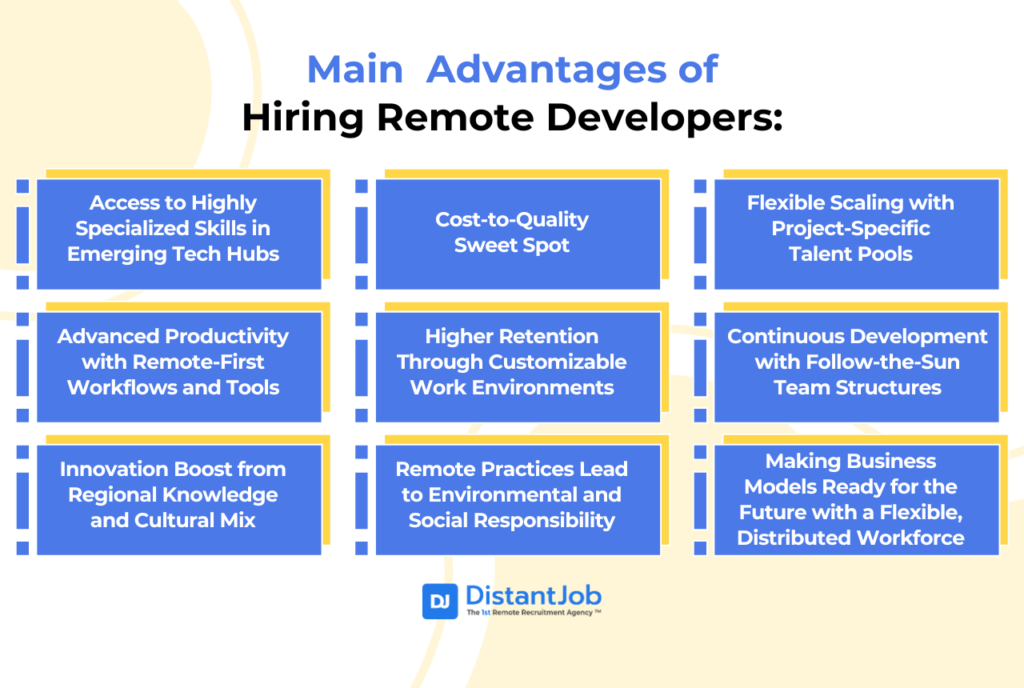Why are American companies doing so well while others just can’t keep up? The answer is simple—by hiring remote developers. This strategy gives them access to specialized skills, new ideas and perspectives, and unparalleled flexibility. And you know what’s more? These are not the only benefits of hiring remote developers—while it expands their access to top talent, it significantly reduces expenses. Since, by finding offshore talent in places like Latin America and Eastern Europe, it eliminates relocation costs, allows companies to skip office overhead, and still secure world-class results.
Think about this: a top developer in Eastern Europe costs 40-60% less than an average US hire, with the same quality. No surprise American companies grow faster, come up with new ideas quicker, and stay ahead in such a tough market.
So, what impact does this method have on business growth? Let’s look at the main advantages and understand why remote hiring is changing the game.

#1 Access to Highly Specialized Skills in Emerging Tech Hubs
Finding niche expertise can be tough, right? When your project needs advanced abilities—like modern software architecture or specialized UI/UX design—searching nearby doesn’t always work. And that’s where remote hiring comes in, changing things by letting you tap into tech centers worldwide known for their unique talent.
Take Poland for example, which is known for creative UI/UX design, or Ukraine, which excels at a wide range of technical knowledge. By looking beyond your local area, you can create a team with the exact know-how your project needs—avoiding the wait and trade-offs that come with old-school hiring.
Why Limit Yourself to Local Talent When You Can Choose from the Whole World?
Hiring remotely doesn’t just link you to better talent—it also speeds up the hiring process. When you focus on areas known for their strengths, you:
- Cut Down Hiring Times: Access existing groups of developers who specialize in your tech stack.
- Boost New Ideas: Bring in experts whose deep local know-how makes your solutions stand out.
- Keep Up Globally: Create software that meets world standards and appeals to different audiences.
How to Do It: A Practical Plan
- Focus on Specific Areas: Check out the strong points of tech centers around the world.
- Use Special Websites: Go beyond regular job sites. GitHub and Stack Overflow show off coders’ real-world abilities, while Behance and Dribbble are great to find design talent.
- Connect with Local Groups: Join online meetups or take part in area-specific open-source projects. These places are full of hidden talent and help you make useful connections.
By looking in more places and focusing on the right spots, you’ll find developers with the skills you need and build a team ready to tackle the specific problems in your field. Because, why narrow your search when you can find talent anywhere in the world?
#2 Cost-to-Quality Sweet Spot
Hiring remote developers helps save money while getting top talent without the financial stray of local salaries. Senior coders from places like Eastern Europe make between $60K-$80K per year, but often outperform US-based mid-level developers who ask for $120K or more annually. This means you get better skills for about half the cost.
By tapping into the global talent pool, companies can keep their standards high and cut costs in a meaningful way. Besides, hiring remote software developers also eliminates extra expenses like moving costs and office bills, which saves even more money.
How Remote Hiring Cuts Salary Costs Without Losing Quality
- Top Skills at Lower Rates: Eastern European programmers produce excellent work for salaries that are almost 40-60% less than their mid-level US counterparts.
- No Hidden Costs: You won’t need to pay for moving expenses, travel costs, or expensive office benefits.
Practical Steps to Save on Salaries
- Focus on Cost-Effective Areas: Look to places like Eastern Europe and Latin America where coders offer both affordability and strong technical know-how.
- Evaluate Your Return: Compare what developers earn to their experience level and work quality. Overseas talent often gives you a better ROI.
- Leverage Global Talent Pools: Use sites like Toptal or team up with IT staffing agencies such as DistantJob that specialize in finding high-performing remote coders.
When you put cost-to-quality hiring first, you cut costs and make sure experts who go above and beyond handle your projects. This explains why US firms are looking to remote coders to stay ahead of the game and grow their business.
#3 Flexible Scaling with Project-Specific Talent Pools
Hiring remote developers gives you the ability to scale dynamically, bringing in experts at the exact stage of your project when you need them. You might need backend engineers to develop your MVP, DevOps specialists to handle deployment, or QA testers before you launch. This lets you build a team that fits your current needs. This approach cuts down on the costs of keeping a big full-time team and allows you to adapt as projects change.
Key Benefits of Flexible Scaling
- Precision Hiring: Hire people with exact skills for each stage, like cybersecurity pros during checks or UI/UX designers to improve products.
- Cost Efficiency: Skip the high costs of full-time jobs for short-term needs.
- Faster Development Cycles: Hit deadlines by adding the right know-how.
How to Put Dynamic Scaling into Action
- Plan by Project Phase: Outline your development cycle to spot when you need special roles.
- Engage Niche Experts: Check out GitHub or tech groups to find people with very specific skills.
- Refine Timelines: Sync new hires with project milestones making sure roles match what you need right now.
Flexible and precise scaling adjusts to your company’s changing needs, speeding up project delivery and boosting productivity. This approach allows your business to respond to new demands while completing work faster and more efficiently.
#4 Advanced Productivity with Remote-First Workflows and Tools
Traditional office settings often create roadblocks to productivity—too many meetings, interruptions, and distractions prevent developers from doing their best work. Remote-first workflows remove these obstacles by creating environments where developers can concentrate and work together seamlessly.
Teams can use tools like Jira, Trello, and Slack to centralize communication, manage tasks, and track progress. This reduces the need to check in giving developers more time to focus on important work. 65% of remote workers say they are more productive, because remote work offers flexibility and quiet environments.
How Remote-First Workflows Boost Productivity
- Uninterrupted Deep Work: Developers can set up distraction-free environments that fit their preferences helping them concentrate, get in the flow, and produce higher-quality code.
- Seamless Tool Integration: Connecting platforms like Slack with Jira or Asana cuts down on misunderstandings by automating updates and keeping the whole team on the same page.
- Flexibility for Peak Performance: Remote work allows developers to code during their most productive times boosting output without strict timetables.
How to Create a Remote-First Workflow
- Pick the Best Tools: Track tasks with project management platforms like Trello or Jira. Use Slack to chat and stay focused.
- Support Work at Different Times: Set up stand-ups or progress updates that don’t need everyone online at once. This lets team members report when it suits them, cutting down on needless meetings.
- Care About Results, Not Time Spent: Pay attention to what gets done, not how long it takes. This builds trust and gives people more control over their work.
When you adopt workflows that put remote work first, you’ll boost how much each person and the whole team can get done. These methods help developers do their best work keeping projects moving and meeting deadlines without a hitch.
#5 Higher Retention Through Customizable Work Environments
Developers thrive when they can create work environments and schedules that suit their individual needs. A quiet home office, a lively co-working space, or even working while on the road can boost job satisfaction and engagement—crucial elements in reducing turnover.
Many developers find flexible working hours have a transformative effect. Some perform best at dawn, while others reach peak productivity late at night. Remote work allows them to work when they’re most effective respecting personal preferences and boosting output.
Why Flexibility Matters
- Custom Workspaces: Developers who have access to comfortable setups—such as two screens, chairs you can adjust, and quiet spaces—say they feel more at ease and can concentrate better, which makes them happier at work.
- Freedom to Set Hours: When companies let developers choose when they work best, it shows trust and helps them do their finest work.
- Better Health: Having the option to work in places that fit their way of life, be it at home or while traveling, builds commitment and helps avoid exhaustion.
How to Attract Developers Through Customization
- Survey for Preferences: Ask developers what they need to feel at ease and get work done. Use their input to create policies.
- Offer Workspace Stipends: Give money to help with home office setups or co-working memberships showing you care about their comfort.
- Introduce Flexible Core Hours: Set specific times for teamwork while letting them plan the rest of their day.
- Prioritize Well-Being: Boost work-life balance by urging breaks and offering resources to support mental health.
Workspaces you can tailor do more than just offer flexibility—they show you value developers as people. These changes, though small, make a big impact. They build trust, keep more people on board, and create a team that stays committed and excited for years to come.
#6 Continuous Development with Follow-the-Sun Team Structures
Picture a work process that keeps going non-stop, with progress happening day and night. A “follow-the-sun” approach makes this possible by using teams spread out across different time zones worldwide. As one team sleeps, another takes over—fixing problems, moving development stages forward, and hitting deadlines quicker. This doesn’t just ensure smooth responses; it also builds toughness during high-stress situations.
Why Follow-the-Sun Works
- Continuous Progress: Teams spread across time zones keep development going non-stop. This cuts down on holdups and speeds up product launches.
- Business Agility: Rapidly growing your team becomes simpler. Your staff is always ready to handle emergencies or take advantage of sudden chances.
- Peak Productivity: Coders work when they’re at their best, which boosts both their output and job satisfaction.
How to Make It Work
- Set Clear Handoff Protocols: Create a standard template for handoffs, which includes key updates, blockers, and next steps. This makes sure every team knows what to expect when they pass tasks.
- Use Asynchronous Tools: Start using tools like Loom to make video updates, Notion to keep all documents in one place, and Jira or Asana to keep track of tasks. These tools help teams communicate well even when they’re not working at the same time.
- Plan Overlapping Core Hours: Set up core hours for important talks between time zones such as Europe-North America or Asia-Europe overlaps. This helps teams stay on the same page about key tasks.
- Track Progress: Apply automated progress updates and shared dashboards to give real-time visibility into project statuses keeping everyone on the same page.
The follow-the-sun model does more than just speed up projects—it has an impact on building business agility and resilience. When you coordinate distributed teams well, your organization can deliver quicker, adjust to challenges, and make sure work keeps going around the clock.
#7 Innovation Boost from Regional Knowledge and Cultural Mix
When different viewpoints come together, innovation flourishes. A globally distributed team offers more than just tech skills—it taps into cultural insights and local expertise that improve your products and services. Developers from different backgrounds bring their own ways of tackling problems, which leads to solutions that are more flexible and focused on users.
How a Mix of Cultures Sparks New Ideas
- Customized Market Solutions: Local teams get how users act in their area. Take coders in Asia for example. They might put mobile-first plans first in places where lots of people use smartphones. Meanwhile, European coders zero in on data privacy features that follow GDPR rules.
- Out-of-the-Box Problem-Solving: Teams with different backgrounds question the usual ways of doing things. This leads to fresh approaches to tough problems. When people from different cultures work together, it sparks ideas that similar teams might not think of.
Ways to Make the Most of Diversity
- Use Regional Know-How: Form teams based on their grasp of local markets. For example, team up developers from North America with those from Asia to handle app launches across different markets.
- Put Money into Cultural Skills: Provide training on cultural skills to build mutual respect and understanding among your team members. Tools like Glint can check team mood and cultural fit.
- Encourage Open Teamwork: Use tools like Miro or Slack to help brainstorming across time zones making sure everyone’s ideas get heard. Mark regional holidays or host online team-building events to create connection and inclusion.
A team with diverse members doesn’t just come up with new ideas—it creates solutions that connect worldwide. When you tap into cultural knowledge, you can make products that go beyond meeting market expectations.
#8 Remote Practices Lead to Environmental and Social Responsibility
Working remotely is more than a way to boost productivity—it’s a chance to be sustainable. When businesses cut down on commuting, shrink their office spaces, and hire people from around the world, they help the environment and society while also making more money.
How Working Helps Sustainability
- Carbon Emission Reductions: Getting rid of daily commutes and offices that use a lot of energy could cut greenhouse gas emissions by 54 million tons every year in the U.S. alone.
- Economic Empowerment in Underserved Regions: When companies hire remote workers in growing economies, they create jobs and help local communities, which leads to economic growth and stability.
How to Have the Biggest Environmental Impact
- Track Sustainability Metrics: Keep tabs on carbon savings from less commuting and energy use. Apps like SustainaBase can help you figure out and show these numbers to stakeholders.
- Team Up with Green Projects: Work with renewable energy efforts or back tech training programs in areas where you hire remote workers. These team-ups boost your brand’s reach.
- Spread the Word: Share fact-based reports on your green efforts to grab eco-minded customers and investors. Show how your remote work rules fit with bigger environmental aims.
When you adopt remote-first practices, your company can strike a balance between profits and responsibility. This has an impact on the environment and helps communities worldwide. It not only makes your brand stronger but also shows that your business leads the way in new sustainable ideas.
#9 Making Business Models Ready for the Future with a Flexible, Distributed Workforce
Adjusting to today’s quick-changing business world needs more than just new ideas—it requires toughness and the ability to change. A flexible spread-out workforce gives companies the power to shift when new trends pop up, from mixed work setups to working together across the globe. By building a culture that’s ready for remote work, businesses make sure they can do well during shake-ups and stay on top in tough markets.
Why Flexibility Is the Future
- Scalable Operations: Distributed teams give businesses the ability to grow or shrink efficiently. They don’t face the same problems with office space or finding local talent. This flexibility keeps work going even when unexpected things happen like economic troubles or worldwide events.
- Diverse Problem-Solving: When workers are spread out geographically, they bring many different viewpoints. This sparks new ideas and clever answers to tricky problems. Teams in different places can combine what they know to tackle issues from many angles. This gives them an edge in fast-changing markets.
- Adaptation to Market Dynamics: Companies with spread-out teams can act when a customer wants to change, new rules come in, or technology moves forward. They don’t get held back by old ways of doing things.
How to Create a Workforce Ready for What’s Next
- Cultivate a Remote-First Culture: A successful distributed team begins with building trust and independence. Set up policies that give employees the power to shape their own work spaces while keeping clear accountability.
- Streamline Collaboration: Put money into tools like Asana, Slack, and Zoom to make communication smooth. Set up rules for work that doesn’t need to happen at the same time to boost productivity across time zones cutting down on holdups and slowdowns.
- Prioritize Continuous Learning: Prepare your team to handle new challenges by giving them chances to improve their skills in new technologies and remote work methods. This could be through online certificates or coaching programs. Focusing on growth helps your workforce stay creative and ready for the future.
- Focus on Results, Not Micromanagement: Turn your attention to outcomes instead of strict timetables. When you give your team members the power to handle their own schedules and produce results, you lift their spirits and create an environment of trust and productivity.
By using these methods, your company sets itself up not just to weather market changes but to lead the way forward. Making your business future-proof means creating a workplace that does well with change and new ideas making sure you’ll succeed for years to come in a world that’s always changing.
Why Remote Work Appeals to Software Developers—and What It Means for Your Business
What attracts developers to remote work? It’s not just about avoiding the commute—it’s about freedom, focus, and fulfillment. Remote jobs allow developers to create personalized schedules that match their peak productivity times enabling early birds or night owls to perform their best. This flexibility increases engagement, improves job satisfaction, and results in better employee retention.
Remote work also removes typical office interruptions providing developers with space to get into the flow state and concentrate on intricate coding projects. Whether they choose a home office or a shared workspace, they can set up environments that boost their productivity and spark their creativity.
Beyond flexibility, remote work has a positive impact on developers’ quality of life by reducing expenses related to commuting and work. This balance allows them to succeed in both personal and professional areas fostering loyalty and commitment to their jobs.
When you adopt remote work, you give developers the independence they prize, creating a setting where they can concentrate, come up with new ideas, and do great work—and this helps your company.
How DistantJob Can Help You Hire the Best Remote Developers
As you can see, leveraging remote work isn’t just about convenience—it’s about unlocking access to global talent, reducing costs, and driving innovation. But the key lies in sourcing the right talent. And that can definitely feel like looking for a needle in a haystack—juggling technical know-how, team fit, and practical challenges can be a lot to handle. And that’s where DistantJob steps in.
We connect you with checked top-notch developers that match what you need. Whether you’re after skilled front-end developers from Eastern Europe or high-level software architects from Latin America, we excel at finding talent that not only meets your technical needs but also fits right in with your team.
Besides locating the perfect match, we tackle the tricky parts. We handle everything from contract management and payroll compliance to time zone issues.
When you team up with DistantJob, you cut down on time, lower hiring risks, and get access to top talent that boosts your business. You can zero in on new ideas and expansion while we build the team that powers your success.
Want to create your ideal team? Let DistantJob help you find developers who will change your business for the better. Get in touch with us now!





